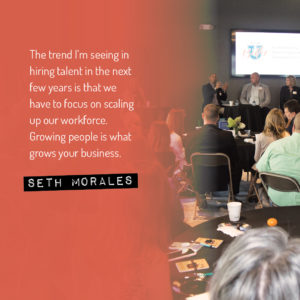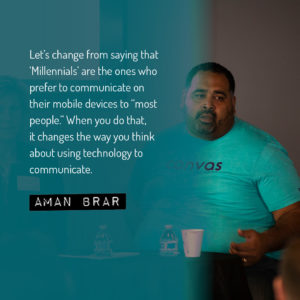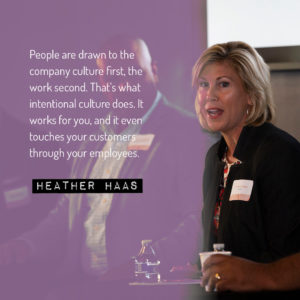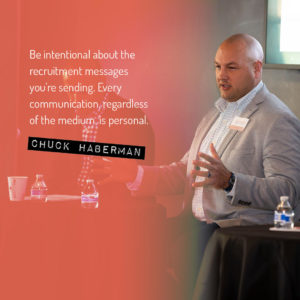Last month, Willow hosted our first Better U panel focused on a challenge we hear from just about every client in every industry or region: how to recruit best fit, ideal team player employees who stay and grow with the organization. Our panelists, Aman Brar, Chuck Haberman, Heather Haas and Seth Morales, all shared perspectives on the state of employment in Indiana as well as their predictions for the future, the opportunities technology presents and why an employer brand is so important in recruiting talent.
Haas, president of ADVISA, shared their clients are all expressing the same frustration: “They’re telling us they can’t find the people they need to grow.” Her team is witnessing firsthand how organizations are built for growth but their inability to find skilled labor is holding them back. And it’s not just in construction, manufacturing and transportation—technology and healthcare are experiencing the same challenges when it comes to finding talent. With the Baby Boomers preparing for retirement there is more thought than ever before on how the business will continue. “Employers need people to carry on what they’ve already built,” shared Haas. “There’s a gap. There’s an empty space between entry-level and retiring executives.”
Morales, President and COO of the Morales Group, agreed and shared there are 100,000 unfilled jobs right here in Indiana. He challenged employers to not work to get talent but to work to scale up talent. The growing “workforce development” role exists for a reason today that didn’t exist 20 years ago. “We have to stop recruiting like it’s 1995. Employers are still relying on traditional advertising and it’s effective to a point but there are better ways to reach the right people,” said Morales.

Opportunities with Technology
And that’s where technology has really made an impact. “We’re communicating differently today. We’re capturing data we weren’t previously focused on. Technology is connecting us at a deeper level. It’s imperative that employers communicate with people the way they want to communicate and share information,” said Canvas President and CEO Aman Brar.
Not to mention, most people are communicating by their mobile device. And, by most people, we mean most people. “Let’s change from saying that Millennials are the ones who prefer to communicate on their mobile devices to ‘most people.’ When you do that, it changes the way you think about using technology to communicate,” added Brar.

Establishing an Employer Brand and Company Culture
Companies are having to rethink their recruitment tactics and process. To Seth’s point, it’s not 1995 anymore and marketers are being tasked more and more with assisting in the recruitment and retention of ideal team players. As a result, the establishment of an employer brand has now been a requirement for organizations looking to attract top talent in a job seeker’s market.
“The employer brand is everything,” shared Gaylor Electric Leader of Workforce Development Chuck Haberman. “It’s so much more than a logo. Recruiters have to live the brand and walk the talk. The employer brand has to translate into everything you do. It’s about building an intentional culture. Employees care more about your why than your what or your how.”
Heather confirmed what we had been suspecting, how employees experience a company culture is one of the most important variables in employee engagement. “Your intentional culture is now more important that your business strategy,” shared Haas. And developing a company or organizational culture starts with defining the employee experience. “A good place to start is to develop and communicate core values. It’s the way you treat people. It’s a recruiting tool. People are drawn to the culture first, the work second.”

Getting Started
Our panel had some great tips on finding and identifying your next employee:
- “Be intentional about the messages you’re sending. Every communication, regardless of the medium, is personal.” – Chuck Haberman
- “Evaluate your recruitment process in comparison with buying a Tesla. It’s probably easier to buy a $100,000 care than to go through your hiring journey. Make it easier.” – Aman Brar
- “Predictive Index, DiSC, or any other assessment tool aren’t effective if you don’t know what you’re looking for. These are tools for leaders to get a better understanding of ‘fit.’ It’s about collecting more data earlier in the process, so we can ask better questions, adapt our approach, and help the potential new hire. Remember, they’re interviewing you as much as you’re interviewing them. Now you have the data, you can design your experiences to create a customized approach.” – Heather Haas

Interested in learning more about recruitment marketing? Check out these books, on the Willow Most Loved List and share your ideas with us.
- Start with Why: How Great Leaders Inspire Everyone to Take Action by Simon Sinek
- The Ideal Team Player by Patrick Lencioni
- Getting Naked by Patrick Lencioni
We’d love to hear how your organization is recruiting and retaining top talent or if you’re looking for some help getting started! Contact us today.
